Birthing on Country: Significances and Consequences
VerifiedAdded on 2023/04/22
|10
|3167
|170
AI Summary
This essay aims at addressing the effect of Birthing on Country, the differences in foetal and child-care among indigenous and non-indigenous communities of Australia and the role of midwifery practices in controlling this dire situation.
Contribute Materials
Your contribution can guide someone’s learning journey. Share your
documents today.

Running head: BIRTHING ON COUNTRY: SIGNIFICANCES AND CONSEQUENSES
BIRTHING ON COUNTRY: SIGNIFICANCES AND CONSEQUENSES
Name of the Student:
Name of the University:
Author’s Note:
BIRTHING ON COUNTRY: SIGNIFICANCES AND CONSEQUENSES
Name of the Student:
Name of the University:
Author’s Note:
Secure Best Marks with AI Grader
Need help grading? Try our AI Grader for instant feedback on your assignments.
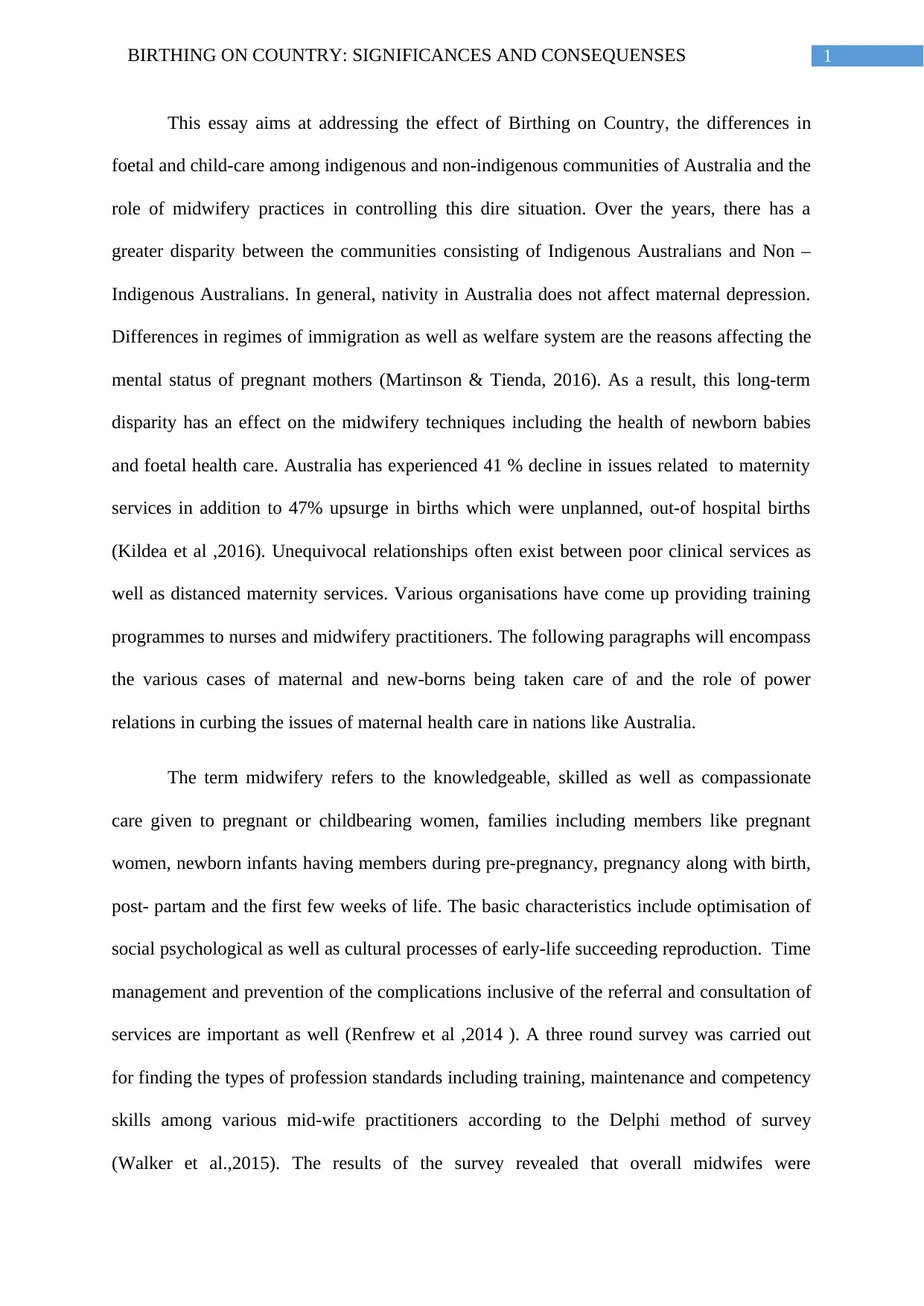
1BIRTHING ON COUNTRY: SIGNIFICANCES AND CONSEQUENSES
This essay aims at addressing the effect of Birthing on Country, the differences in
foetal and child-care among indigenous and non-indigenous communities of Australia and the
role of midwifery practices in controlling this dire situation. Over the years, there has a
greater disparity between the communities consisting of Indigenous Australians and Non –
Indigenous Australians. In general, nativity in Australia does not affect maternal depression.
Differences in regimes of immigration as well as welfare system are the reasons affecting the
mental status of pregnant mothers (Martinson & Tienda, 2016). As a result, this long-term
disparity has an effect on the midwifery techniques including the health of newborn babies
and foetal health care. Australia has experienced 41 % decline in issues related to maternity
services in addition to 47% upsurge in births which were unplanned, out-of hospital births
(Kildea et al ,2016). Unequivocal relationships often exist between poor clinical services as
well as distanced maternity services. Various organisations have come up providing training
programmes to nurses and midwifery practitioners. The following paragraphs will encompass
the various cases of maternal and new-borns being taken care of and the role of power
relations in curbing the issues of maternal health care in nations like Australia.
The term midwifery refers to the knowledgeable, skilled as well as compassionate
care given to pregnant or childbearing women, families including members like pregnant
women, newborn infants having members during pre-pregnancy, pregnancy along with birth,
post- partam and the first few weeks of life. The basic characteristics include optimisation of
social psychological as well as cultural processes of early-life succeeding reproduction. Time
management and prevention of the complications inclusive of the referral and consultation of
services are important as well (Renfrew et al ,2014 ). A three round survey was carried out
for finding the types of profession standards including training, maintenance and competency
skills among various mid-wife practitioners according to the Delphi method of survey
(Walker et al.,2015). The results of the survey revealed that overall midwifes were
This essay aims at addressing the effect of Birthing on Country, the differences in
foetal and child-care among indigenous and non-indigenous communities of Australia and the
role of midwifery practices in controlling this dire situation. Over the years, there has a
greater disparity between the communities consisting of Indigenous Australians and Non –
Indigenous Australians. In general, nativity in Australia does not affect maternal depression.
Differences in regimes of immigration as well as welfare system are the reasons affecting the
mental status of pregnant mothers (Martinson & Tienda, 2016). As a result, this long-term
disparity has an effect on the midwifery techniques including the health of newborn babies
and foetal health care. Australia has experienced 41 % decline in issues related to maternity
services in addition to 47% upsurge in births which were unplanned, out-of hospital births
(Kildea et al ,2016). Unequivocal relationships often exist between poor clinical services as
well as distanced maternity services. Various organisations have come up providing training
programmes to nurses and midwifery practitioners. The following paragraphs will encompass
the various cases of maternal and new-borns being taken care of and the role of power
relations in curbing the issues of maternal health care in nations like Australia.
The term midwifery refers to the knowledgeable, skilled as well as compassionate
care given to pregnant or childbearing women, families including members like pregnant
women, newborn infants having members during pre-pregnancy, pregnancy along with birth,
post- partam and the first few weeks of life. The basic characteristics include optimisation of
social psychological as well as cultural processes of early-life succeeding reproduction. Time
management and prevention of the complications inclusive of the referral and consultation of
services are important as well (Renfrew et al ,2014 ). A three round survey was carried out
for finding the types of profession standards including training, maintenance and competency
skills among various mid-wife practitioners according to the Delphi method of survey
(Walker et al.,2015). The results of the survey revealed that overall midwifes were
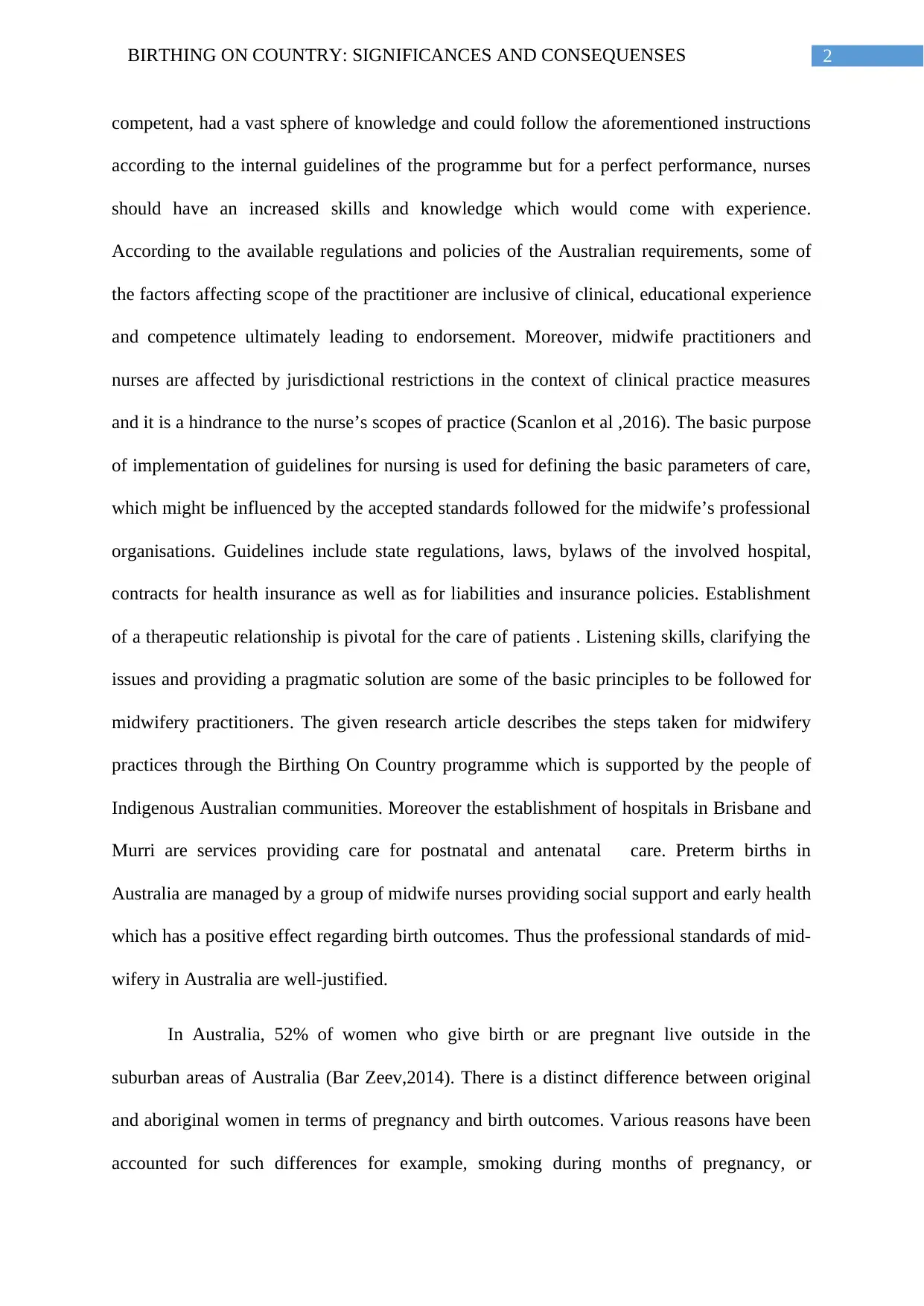
2BIRTHING ON COUNTRY: SIGNIFICANCES AND CONSEQUENSES
competent, had a vast sphere of knowledge and could follow the aforementioned instructions
according to the internal guidelines of the programme but for a perfect performance, nurses
should have an increased skills and knowledge which would come with experience.
According to the available regulations and policies of the Australian requirements, some of
the factors affecting scope of the practitioner are inclusive of clinical, educational experience
and competence ultimately leading to endorsement. Moreover, midwife practitioners and
nurses are affected by jurisdictional restrictions in the context of clinical practice measures
and it is a hindrance to the nurse’s scopes of practice (Scanlon et al ,2016). The basic purpose
of implementation of guidelines for nursing is used for defining the basic parameters of care,
which might be influenced by the accepted standards followed for the midwife’s professional
organisations. Guidelines include state regulations, laws, bylaws of the involved hospital,
contracts for health insurance as well as for liabilities and insurance policies. Establishment
of a therapeutic relationship is pivotal for the care of patients . Listening skills, clarifying the
issues and providing a pragmatic solution are some of the basic principles to be followed for
midwifery practitioners. The given research article describes the steps taken for midwifery
practices through the Birthing On Country programme which is supported by the people of
Indigenous Australian communities. Moreover the establishment of hospitals in Brisbane and
Murri are services providing care for postnatal and antenatal care. Preterm births in
Australia are managed by a group of midwife nurses providing social support and early health
which has a positive effect regarding birth outcomes. Thus the professional standards of mid-
wifery in Australia are well-justified.
In Australia, 52% of women who give birth or are pregnant live outside in the
suburban areas of Australia (Bar Zeev,2014). There is a distinct difference between original
and aboriginal women in terms of pregnancy and birth outcomes. Various reasons have been
accounted for such differences for example, smoking during months of pregnancy, or
competent, had a vast sphere of knowledge and could follow the aforementioned instructions
according to the internal guidelines of the programme but for a perfect performance, nurses
should have an increased skills and knowledge which would come with experience.
According to the available regulations and policies of the Australian requirements, some of
the factors affecting scope of the practitioner are inclusive of clinical, educational experience
and competence ultimately leading to endorsement. Moreover, midwife practitioners and
nurses are affected by jurisdictional restrictions in the context of clinical practice measures
and it is a hindrance to the nurse’s scopes of practice (Scanlon et al ,2016). The basic purpose
of implementation of guidelines for nursing is used for defining the basic parameters of care,
which might be influenced by the accepted standards followed for the midwife’s professional
organisations. Guidelines include state regulations, laws, bylaws of the involved hospital,
contracts for health insurance as well as for liabilities and insurance policies. Establishment
of a therapeutic relationship is pivotal for the care of patients . Listening skills, clarifying the
issues and providing a pragmatic solution are some of the basic principles to be followed for
midwifery practitioners. The given research article describes the steps taken for midwifery
practices through the Birthing On Country programme which is supported by the people of
Indigenous Australian communities. Moreover the establishment of hospitals in Brisbane and
Murri are services providing care for postnatal and antenatal care. Preterm births in
Australia are managed by a group of midwife nurses providing social support and early health
which has a positive effect regarding birth outcomes. Thus the professional standards of mid-
wifery in Australia are well-justified.
In Australia, 52% of women who give birth or are pregnant live outside in the
suburban areas of Australia (Bar Zeev,2014). There is a distinct difference between original
and aboriginal women in terms of pregnancy and birth outcomes. Various reasons have been
accounted for such differences for example, smoking during months of pregnancy, or
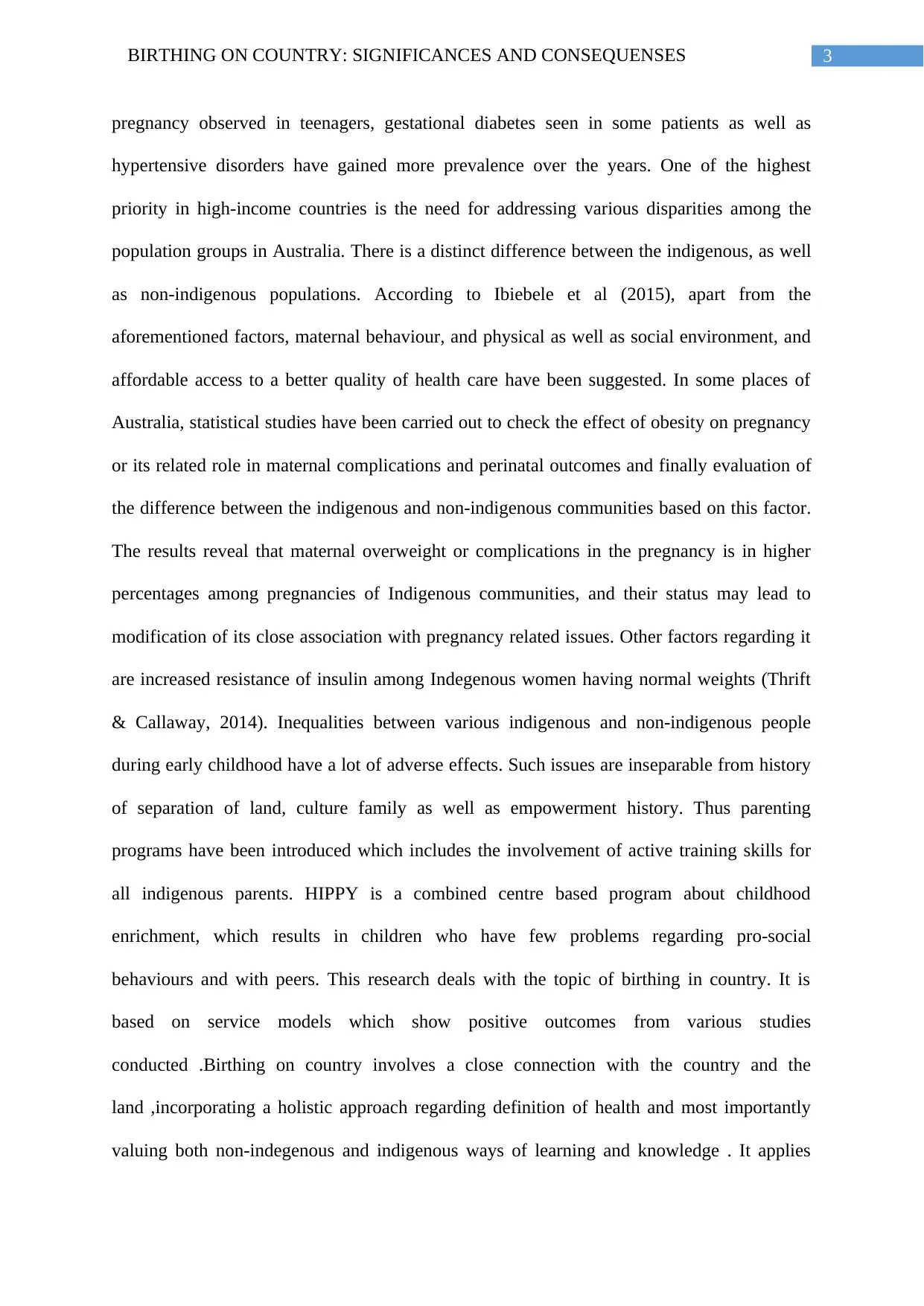
3BIRTHING ON COUNTRY: SIGNIFICANCES AND CONSEQUENSES
pregnancy observed in teenagers, gestational diabetes seen in some patients as well as
hypertensive disorders have gained more prevalence over the years. One of the highest
priority in high-income countries is the need for addressing various disparities among the
population groups in Australia. There is a distinct difference between the indigenous, as well
as non-indigenous populations. According to Ibiebele et al (2015), apart from the
aforementioned factors, maternal behaviour, and physical as well as social environment, and
affordable access to a better quality of health care have been suggested. In some places of
Australia, statistical studies have been carried out to check the effect of obesity on pregnancy
or its related role in maternal complications and perinatal outcomes and finally evaluation of
the difference between the indigenous and non-indigenous communities based on this factor.
The results reveal that maternal overweight or complications in the pregnancy is in higher
percentages among pregnancies of Indigenous communities, and their status may lead to
modification of its close association with pregnancy related issues. Other factors regarding it
are increased resistance of insulin among Indegenous women having normal weights (Thrift
& Callaway, 2014). Inequalities between various indigenous and non-indigenous people
during early childhood have a lot of adverse effects. Such issues are inseparable from history
of separation of land, culture family as well as empowerment history. Thus parenting
programs have been introduced which includes the involvement of active training skills for
all indigenous parents. HIPPY is a combined centre based program about childhood
enrichment, which results in children who have few problems regarding pro-social
behaviours and with peers. This research deals with the topic of birthing in country. It is
based on service models which show positive outcomes from various studies
conducted .Birthing on country involves a close connection with the country and the
land ,incorporating a holistic approach regarding definition of health and most importantly
valuing both non-indegenous and indigenous ways of learning and knowledge . It applies
pregnancy observed in teenagers, gestational diabetes seen in some patients as well as
hypertensive disorders have gained more prevalence over the years. One of the highest
priority in high-income countries is the need for addressing various disparities among the
population groups in Australia. There is a distinct difference between the indigenous, as well
as non-indigenous populations. According to Ibiebele et al (2015), apart from the
aforementioned factors, maternal behaviour, and physical as well as social environment, and
affordable access to a better quality of health care have been suggested. In some places of
Australia, statistical studies have been carried out to check the effect of obesity on pregnancy
or its related role in maternal complications and perinatal outcomes and finally evaluation of
the difference between the indigenous and non-indigenous communities based on this factor.
The results reveal that maternal overweight or complications in the pregnancy is in higher
percentages among pregnancies of Indigenous communities, and their status may lead to
modification of its close association with pregnancy related issues. Other factors regarding it
are increased resistance of insulin among Indegenous women having normal weights (Thrift
& Callaway, 2014). Inequalities between various indigenous and non-indigenous people
during early childhood have a lot of adverse effects. Such issues are inseparable from history
of separation of land, culture family as well as empowerment history. Thus parenting
programs have been introduced which includes the involvement of active training skills for
all indigenous parents. HIPPY is a combined centre based program about childhood
enrichment, which results in children who have few problems regarding pro-social
behaviours and with peers. This research deals with the topic of birthing in country. It is
based on service models which show positive outcomes from various studies
conducted .Birthing on country involves a close connection with the country and the
land ,incorporating a holistic approach regarding definition of health and most importantly
valuing both non-indegenous and indigenous ways of learning and knowledge . It applies
Secure Best Marks with AI Grader
Need help grading? Try our AI Grader for instant feedback on your assignments.
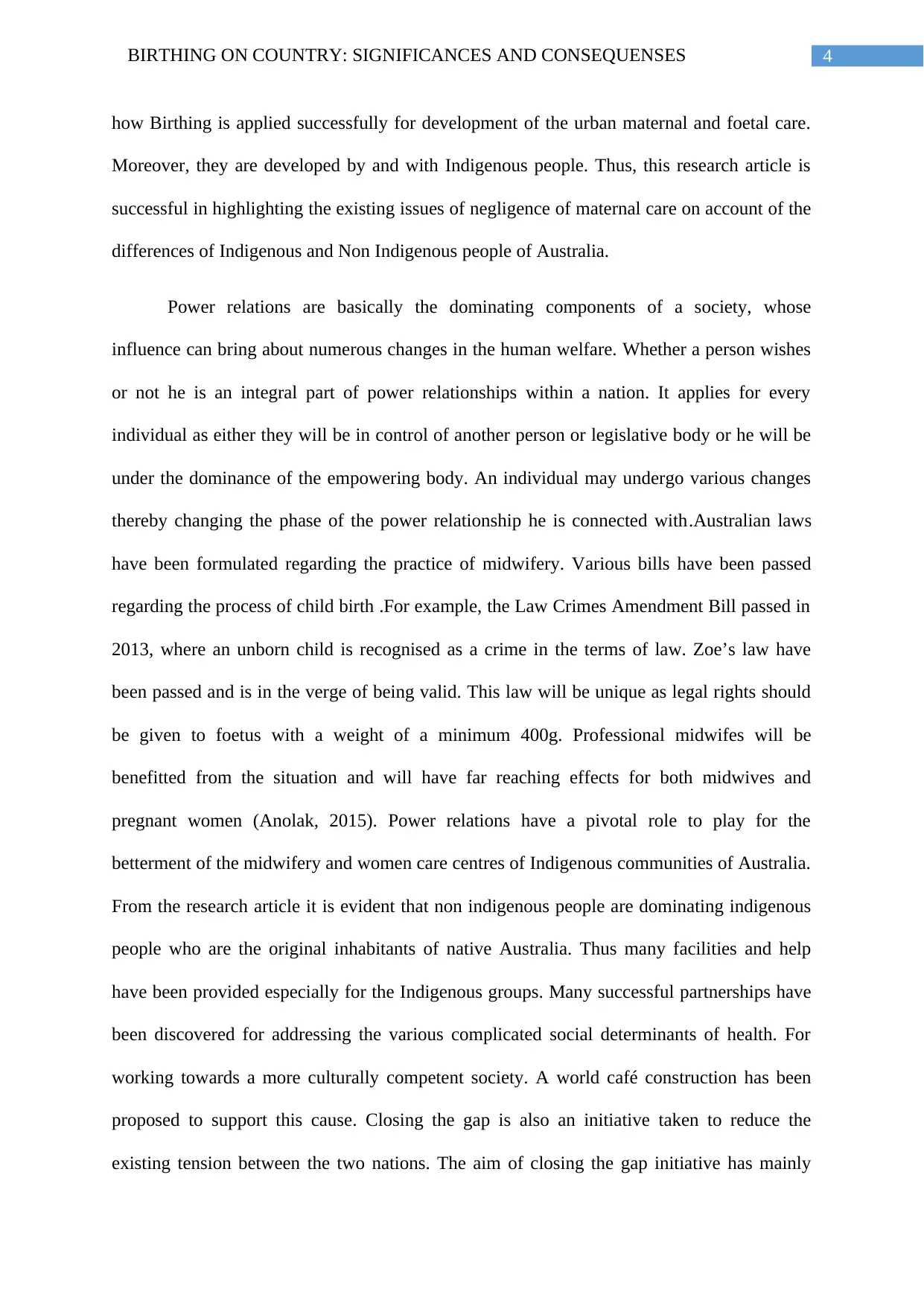
4BIRTHING ON COUNTRY: SIGNIFICANCES AND CONSEQUENSES
how Birthing is applied successfully for development of the urban maternal and foetal care.
Moreover, they are developed by and with Indigenous people. Thus, this research article is
successful in highlighting the existing issues of negligence of maternal care on account of the
differences of Indigenous and Non Indigenous people of Australia.
Power relations are basically the dominating components of a society, whose
influence can bring about numerous changes in the human welfare. Whether a person wishes
or not he is an integral part of power relationships within a nation. It applies for every
individual as either they will be in control of another person or legislative body or he will be
under the dominance of the empowering body. An individual may undergo various changes
thereby changing the phase of the power relationship he is connected with.Australian laws
have been formulated regarding the practice of midwifery. Various bills have been passed
regarding the process of child birth .For example, the Law Crimes Amendment Bill passed in
2013, where an unborn child is recognised as a crime in the terms of law. Zoe’s law have
been passed and is in the verge of being valid. This law will be unique as legal rights should
be given to foetus with a weight of a minimum 400g. Professional midwifes will be
benefitted from the situation and will have far reaching effects for both midwives and
pregnant women (Anolak, 2015). Power relations have a pivotal role to play for the
betterment of the midwifery and women care centres of Indigenous communities of Australia.
From the research article it is evident that non indigenous people are dominating indigenous
people who are the original inhabitants of native Australia. Thus many facilities and help
have been provided especially for the Indigenous groups. Many successful partnerships have
been discovered for addressing the various complicated social determinants of health. For
working towards a more culturally competent society. A world café construction has been
proposed to support this cause. Closing the gap is also an initiative taken to reduce the
existing tension between the two nations. The aim of closing the gap initiative has mainly
how Birthing is applied successfully for development of the urban maternal and foetal care.
Moreover, they are developed by and with Indigenous people. Thus, this research article is
successful in highlighting the existing issues of negligence of maternal care on account of the
differences of Indigenous and Non Indigenous people of Australia.
Power relations are basically the dominating components of a society, whose
influence can bring about numerous changes in the human welfare. Whether a person wishes
or not he is an integral part of power relationships within a nation. It applies for every
individual as either they will be in control of another person or legislative body or he will be
under the dominance of the empowering body. An individual may undergo various changes
thereby changing the phase of the power relationship he is connected with.Australian laws
have been formulated regarding the practice of midwifery. Various bills have been passed
regarding the process of child birth .For example, the Law Crimes Amendment Bill passed in
2013, where an unborn child is recognised as a crime in the terms of law. Zoe’s law have
been passed and is in the verge of being valid. This law will be unique as legal rights should
be given to foetus with a weight of a minimum 400g. Professional midwifes will be
benefitted from the situation and will have far reaching effects for both midwives and
pregnant women (Anolak, 2015). Power relations have a pivotal role to play for the
betterment of the midwifery and women care centres of Indigenous communities of Australia.
From the research article it is evident that non indigenous people are dominating indigenous
people who are the original inhabitants of native Australia. Thus many facilities and help
have been provided especially for the Indigenous groups. Many successful partnerships have
been discovered for addressing the various complicated social determinants of health. For
working towards a more culturally competent society. A world café construction has been
proposed to support this cause. Closing the gap is also an initiative taken to reduce the
existing tension between the two nations. The aim of closing the gap initiative has mainly
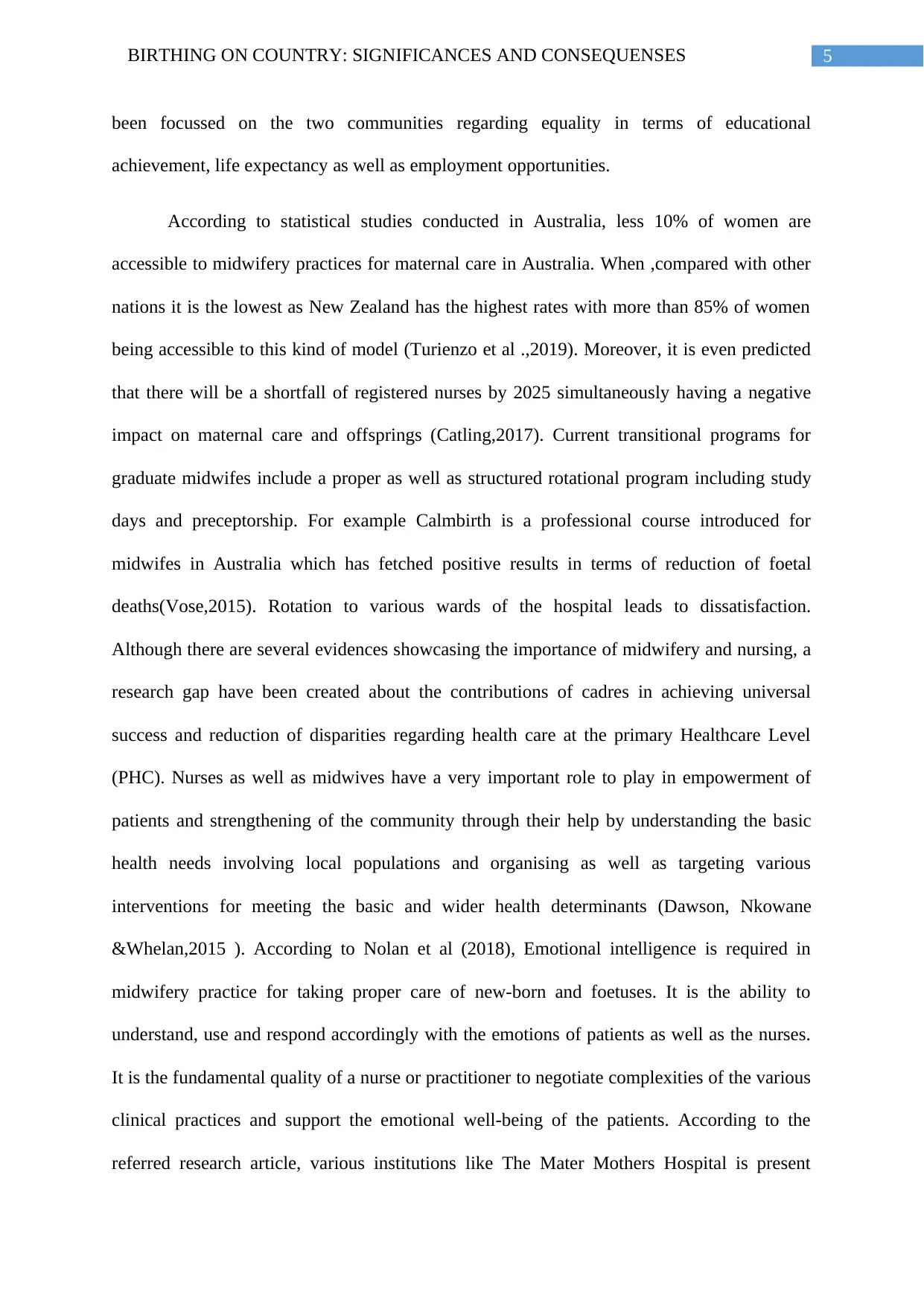
5BIRTHING ON COUNTRY: SIGNIFICANCES AND CONSEQUENSES
been focussed on the two communities regarding equality in terms of educational
achievement, life expectancy as well as employment opportunities.
According to statistical studies conducted in Australia, less 10% of women are
accessible to midwifery practices for maternal care in Australia. When ,compared with other
nations it is the lowest as New Zealand has the highest rates with more than 85% of women
being accessible to this kind of model (Turienzo et al .,2019). Moreover, it is even predicted
that there will be a shortfall of registered nurses by 2025 simultaneously having a negative
impact on maternal care and offsprings (Catling,2017). Current transitional programs for
graduate midwifes include a proper as well as structured rotational program including study
days and preceptorship. For example Calmbirth is a professional course introduced for
midwifes in Australia which has fetched positive results in terms of reduction of foetal
deaths(Vose,2015). Rotation to various wards of the hospital leads to dissatisfaction.
Although there are several evidences showcasing the importance of midwifery and nursing, a
research gap have been created about the contributions of cadres in achieving universal
success and reduction of disparities regarding health care at the primary Healthcare Level
(PHC). Nurses as well as midwives have a very important role to play in empowerment of
patients and strengthening of the community through their help by understanding the basic
health needs involving local populations and organising as well as targeting various
interventions for meeting the basic and wider health determinants (Dawson, Nkowane
&Whelan,2015 ). According to Nolan et al (2018), Emotional intelligence is required in
midwifery practice for taking proper care of new-born and foetuses. It is the ability to
understand, use and respond accordingly with the emotions of patients as well as the nurses.
It is the fundamental quality of a nurse or practitioner to negotiate complexities of the various
clinical practices and support the emotional well-being of the patients. According to the
referred research article, various institutions like The Mater Mothers Hospital is present
been focussed on the two communities regarding equality in terms of educational
achievement, life expectancy as well as employment opportunities.
According to statistical studies conducted in Australia, less 10% of women are
accessible to midwifery practices for maternal care in Australia. When ,compared with other
nations it is the lowest as New Zealand has the highest rates with more than 85% of women
being accessible to this kind of model (Turienzo et al .,2019). Moreover, it is even predicted
that there will be a shortfall of registered nurses by 2025 simultaneously having a negative
impact on maternal care and offsprings (Catling,2017). Current transitional programs for
graduate midwifes include a proper as well as structured rotational program including study
days and preceptorship. For example Calmbirth is a professional course introduced for
midwifes in Australia which has fetched positive results in terms of reduction of foetal
deaths(Vose,2015). Rotation to various wards of the hospital leads to dissatisfaction.
Although there are several evidences showcasing the importance of midwifery and nursing, a
research gap have been created about the contributions of cadres in achieving universal
success and reduction of disparities regarding health care at the primary Healthcare Level
(PHC). Nurses as well as midwives have a very important role to play in empowerment of
patients and strengthening of the community through their help by understanding the basic
health needs involving local populations and organising as well as targeting various
interventions for meeting the basic and wider health determinants (Dawson, Nkowane
&Whelan,2015 ). According to Nolan et al (2018), Emotional intelligence is required in
midwifery practice for taking proper care of new-born and foetuses. It is the ability to
understand, use and respond accordingly with the emotions of patients as well as the nurses.
It is the fundamental quality of a nurse or practitioner to negotiate complexities of the various
clinical practices and support the emotional well-being of the patients. According to the
referred research article, various institutions like The Mater Mothers Hospital is present

6BIRTHING ON COUNTRY: SIGNIFICANCES AND CONSEQUENSES
alongside the Indigenous Murri Antenatal Clinic which provide obstetric and midwifery
continuity of care regarding midwifery practice. Moreover, women undergoing ceaserean
births are vulnerable and much more chances of decreased survival rates. This makes them
the primary groups of care from midwife practitioners. Interventions are an important
component of the traning programmes for nurses including obstetric interventions which are
the most important issues realted to maternal and healthcare (Wong et al 2015). A gap has
been found between the maternal and new-born health of Indigenous and non- indigenous
communities of Australia due to various factors. Thus closing the gap initiative will also be
beneficial in this perspective, taking care of maternal pregnancies of both Australian
communities especially the Indigenous communities.
Thus, it can be concluded from the following paragraphs that the effect of Birthing on
Country has a significant differences with respect to the indigenous and nonindigenous
communities of Australia. Moreover, such differences along with the influence of power
relations are affecting the practice of midwifery which is in general having an impact of new
borns and child health care inclusive of care of pregnant women and those undergoing
various stages of pregnancy. This article focuses on the development of institutions and
hospital to bridge the gap existing between the Indigenous and Non Indigenous groups of
Australia. Birthing on Country is another initiative taken towards the benefit of the Nation
trying to cope up with the facilities regarding maternal health care which the country is
already lacking behind. This article moreover encourages the role of mid-wife practitioners
and their role of providing care for the upliftment of pregnant women and their children.
Nurses should take care of their patients as a primary and compulsory step towards Primary
Health Care. Special training programmes should be included for increase in knowledge and
expertise of midwife nurses which will be a pragmatic solution to this issue and problems
related to such issues in the upcoming future.
alongside the Indigenous Murri Antenatal Clinic which provide obstetric and midwifery
continuity of care regarding midwifery practice. Moreover, women undergoing ceaserean
births are vulnerable and much more chances of decreased survival rates. This makes them
the primary groups of care from midwife practitioners. Interventions are an important
component of the traning programmes for nurses including obstetric interventions which are
the most important issues realted to maternal and healthcare (Wong et al 2015). A gap has
been found between the maternal and new-born health of Indigenous and non- indigenous
communities of Australia due to various factors. Thus closing the gap initiative will also be
beneficial in this perspective, taking care of maternal pregnancies of both Australian
communities especially the Indigenous communities.
Thus, it can be concluded from the following paragraphs that the effect of Birthing on
Country has a significant differences with respect to the indigenous and nonindigenous
communities of Australia. Moreover, such differences along with the influence of power
relations are affecting the practice of midwifery which is in general having an impact of new
borns and child health care inclusive of care of pregnant women and those undergoing
various stages of pregnancy. This article focuses on the development of institutions and
hospital to bridge the gap existing between the Indigenous and Non Indigenous groups of
Australia. Birthing on Country is another initiative taken towards the benefit of the Nation
trying to cope up with the facilities regarding maternal health care which the country is
already lacking behind. This article moreover encourages the role of mid-wife practitioners
and their role of providing care for the upliftment of pregnant women and their children.
Nurses should take care of their patients as a primary and compulsory step towards Primary
Health Care. Special training programmes should be included for increase in knowledge and
expertise of midwife nurses which will be a pragmatic solution to this issue and problems
related to such issues in the upcoming future.
Paraphrase This Document
Need a fresh take? Get an instant paraphrase of this document with our AI Paraphraser
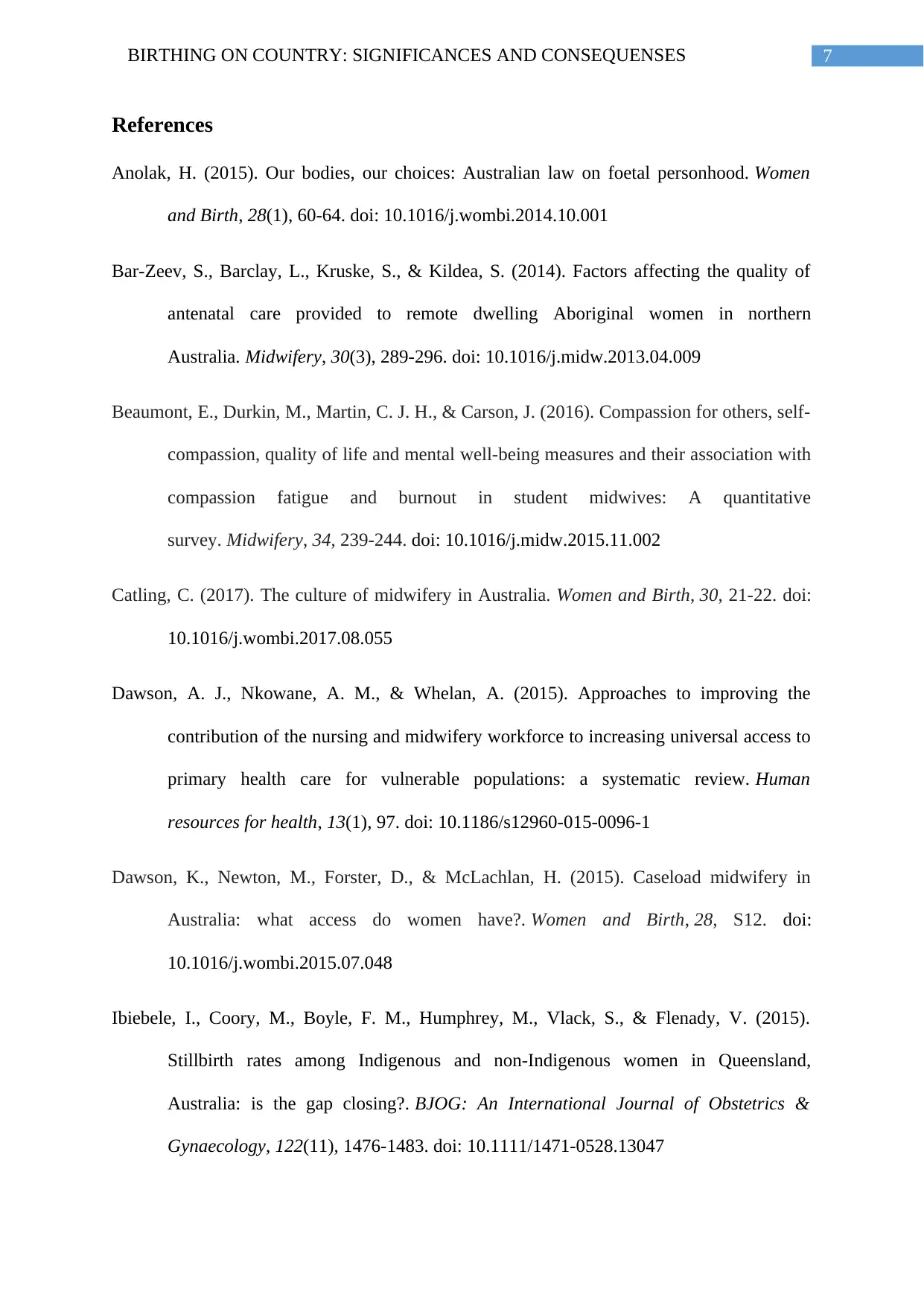
7BIRTHING ON COUNTRY: SIGNIFICANCES AND CONSEQUENSES
References
Anolak, H. (2015). Our bodies, our choices: Australian law on foetal personhood. Women
and Birth, 28(1), 60-64. doi: 10.1016/j.wombi.2014.10.001
Bar-Zeev, S., Barclay, L., Kruske, S., & Kildea, S. (2014). Factors affecting the quality of
antenatal care provided to remote dwelling Aboriginal women in northern
Australia. Midwifery, 30(3), 289-296. doi: 10.1016/j.midw.2013.04.009
Beaumont, E., Durkin, M., Martin, C. J. H., & Carson, J. (2016). Compassion for others, self-
compassion, quality of life and mental well-being measures and their association with
compassion fatigue and burnout in student midwives: A quantitative
survey. Midwifery, 34, 239-244. doi: 10.1016/j.midw.2015.11.002
Catling, C. (2017). The culture of midwifery in Australia. Women and Birth, 30, 21-22. doi:
10.1016/j.wombi.2017.08.055
Dawson, A. J., Nkowane, A. M., & Whelan, A. (2015). Approaches to improving the
contribution of the nursing and midwifery workforce to increasing universal access to
primary health care for vulnerable populations: a systematic review. Human
resources for health, 13(1), 97. doi: 10.1186/s12960-015-0096-1
Dawson, K., Newton, M., Forster, D., & McLachlan, H. (2015). Caseload midwifery in
Australia: what access do women have?. Women and Birth, 28, S12. doi:
10.1016/j.wombi.2015.07.048
Ibiebele, I., Coory, M., Boyle, F. M., Humphrey, M., Vlack, S., & Flenady, V. (2015).
Stillbirth rates among Indigenous and non‐Indigenous women in Queensland,
Australia: is the gap closing?. BJOG: An International Journal of Obstetrics &
Gynaecology, 122(11), 1476-1483. doi: 10.1111/1471-0528.13047
References
Anolak, H. (2015). Our bodies, our choices: Australian law on foetal personhood. Women
and Birth, 28(1), 60-64. doi: 10.1016/j.wombi.2014.10.001
Bar-Zeev, S., Barclay, L., Kruske, S., & Kildea, S. (2014). Factors affecting the quality of
antenatal care provided to remote dwelling Aboriginal women in northern
Australia. Midwifery, 30(3), 289-296. doi: 10.1016/j.midw.2013.04.009
Beaumont, E., Durkin, M., Martin, C. J. H., & Carson, J. (2016). Compassion for others, self-
compassion, quality of life and mental well-being measures and their association with
compassion fatigue and burnout in student midwives: A quantitative
survey. Midwifery, 34, 239-244. doi: 10.1016/j.midw.2015.11.002
Catling, C. (2017). The culture of midwifery in Australia. Women and Birth, 30, 21-22. doi:
10.1016/j.wombi.2017.08.055
Dawson, A. J., Nkowane, A. M., & Whelan, A. (2015). Approaches to improving the
contribution of the nursing and midwifery workforce to increasing universal access to
primary health care for vulnerable populations: a systematic review. Human
resources for health, 13(1), 97. doi: 10.1186/s12960-015-0096-1
Dawson, K., Newton, M., Forster, D., & McLachlan, H. (2015). Caseload midwifery in
Australia: what access do women have?. Women and Birth, 28, S12. doi:
10.1016/j.wombi.2015.07.048
Ibiebele, I., Coory, M., Boyle, F. M., Humphrey, M., Vlack, S., & Flenady, V. (2015).
Stillbirth rates among Indigenous and non‐Indigenous women in Queensland,
Australia: is the gap closing?. BJOG: An International Journal of Obstetrics &
Gynaecology, 122(11), 1476-1483. doi: 10.1111/1471-0528.13047
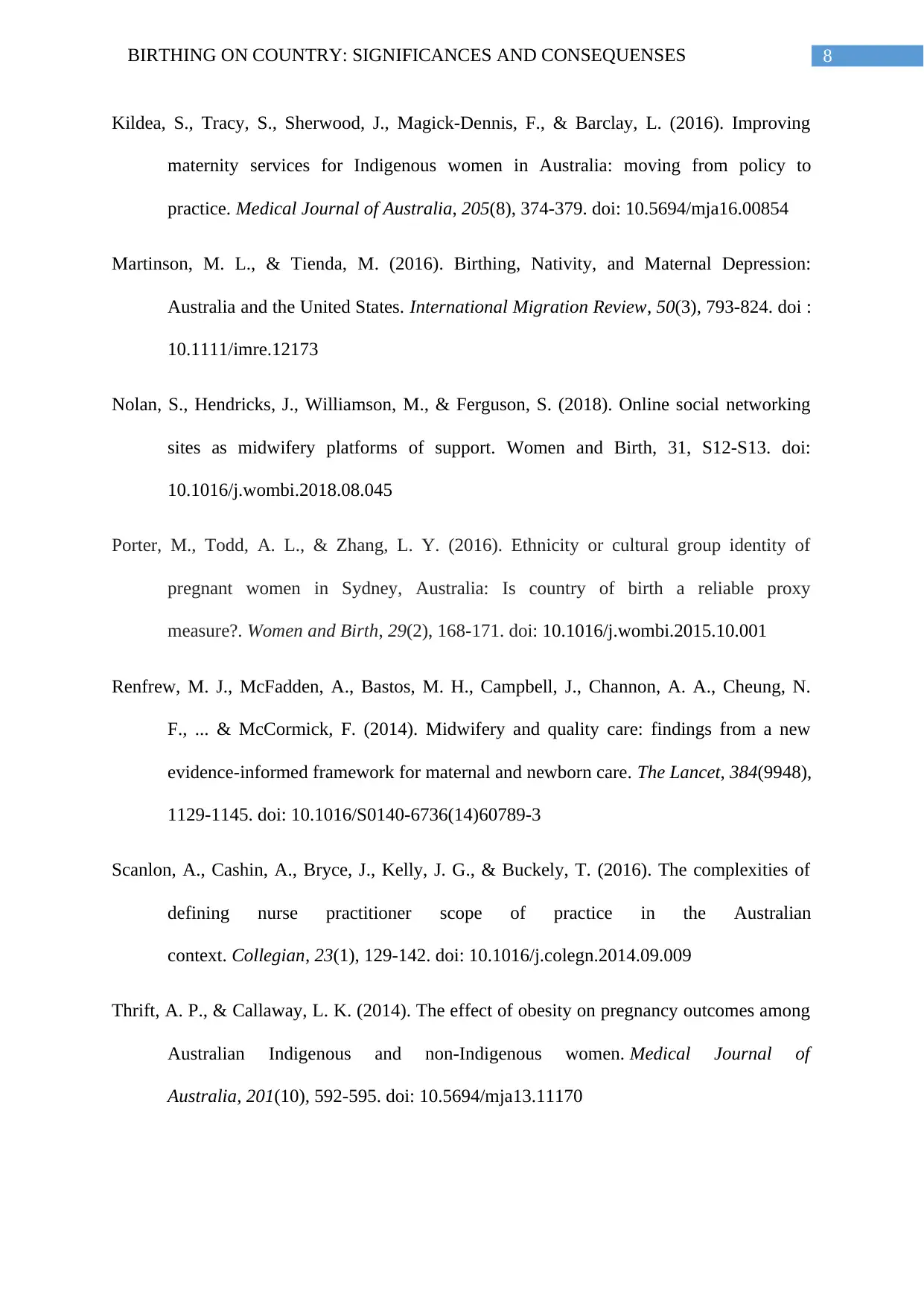
8BIRTHING ON COUNTRY: SIGNIFICANCES AND CONSEQUENSES
Kildea, S., Tracy, S., Sherwood, J., Magick‐Dennis, F., & Barclay, L. (2016). Improving
maternity services for Indigenous women in Australia: moving from policy to
practice. Medical Journal of Australia, 205(8), 374-379. doi: 10.5694/mja16.00854
Martinson, M. L., & Tienda, M. (2016). Birthing, Nativity, and Maternal Depression:
Australia and the United States. International Migration Review, 50(3), 793-824. doi :
10.1111/imre.12173
Nolan, S., Hendricks, J., Williamson, M., & Ferguson, S. (2018). Online social networking
sites as midwifery platforms of support. Women and Birth, 31, S12-S13. doi:
10.1016/j.wombi.2018.08.045
Porter, M., Todd, A. L., & Zhang, L. Y. (2016). Ethnicity or cultural group identity of
pregnant women in Sydney, Australia: Is country of birth a reliable proxy
measure?. Women and Birth, 29(2), 168-171. doi: 10.1016/j.wombi.2015.10.001
Renfrew, M. J., McFadden, A., Bastos, M. H., Campbell, J., Channon, A. A., Cheung, N.
F., ... & McCormick, F. (2014). Midwifery and quality care: findings from a new
evidence-informed framework for maternal and newborn care. The Lancet, 384(9948),
1129-1145. doi: 10.1016/S0140-6736(14)60789-3
Scanlon, A., Cashin, A., Bryce, J., Kelly, J. G., & Buckely, T. (2016). The complexities of
defining nurse practitioner scope of practice in the Australian
context. Collegian, 23(1), 129-142. doi: 10.1016/j.colegn.2014.09.009
Thrift, A. P., & Callaway, L. K. (2014). The effect of obesity on pregnancy outcomes among
Australian Indigenous and non‐Indigenous women. Medical Journal of
Australia, 201(10), 592-595. doi: 10.5694/mja13.11170
Kildea, S., Tracy, S., Sherwood, J., Magick‐Dennis, F., & Barclay, L. (2016). Improving
maternity services for Indigenous women in Australia: moving from policy to
practice. Medical Journal of Australia, 205(8), 374-379. doi: 10.5694/mja16.00854
Martinson, M. L., & Tienda, M. (2016). Birthing, Nativity, and Maternal Depression:
Australia and the United States. International Migration Review, 50(3), 793-824. doi :
10.1111/imre.12173
Nolan, S., Hendricks, J., Williamson, M., & Ferguson, S. (2018). Online social networking
sites as midwifery platforms of support. Women and Birth, 31, S12-S13. doi:
10.1016/j.wombi.2018.08.045
Porter, M., Todd, A. L., & Zhang, L. Y. (2016). Ethnicity or cultural group identity of
pregnant women in Sydney, Australia: Is country of birth a reliable proxy
measure?. Women and Birth, 29(2), 168-171. doi: 10.1016/j.wombi.2015.10.001
Renfrew, M. J., McFadden, A., Bastos, M. H., Campbell, J., Channon, A. A., Cheung, N.
F., ... & McCormick, F. (2014). Midwifery and quality care: findings from a new
evidence-informed framework for maternal and newborn care. The Lancet, 384(9948),
1129-1145. doi: 10.1016/S0140-6736(14)60789-3
Scanlon, A., Cashin, A., Bryce, J., Kelly, J. G., & Buckely, T. (2016). The complexities of
defining nurse practitioner scope of practice in the Australian
context. Collegian, 23(1), 129-142. doi: 10.1016/j.colegn.2014.09.009
Thrift, A. P., & Callaway, L. K. (2014). The effect of obesity on pregnancy outcomes among
Australian Indigenous and non‐Indigenous women. Medical Journal of
Australia, 201(10), 592-595. doi: 10.5694/mja13.11170
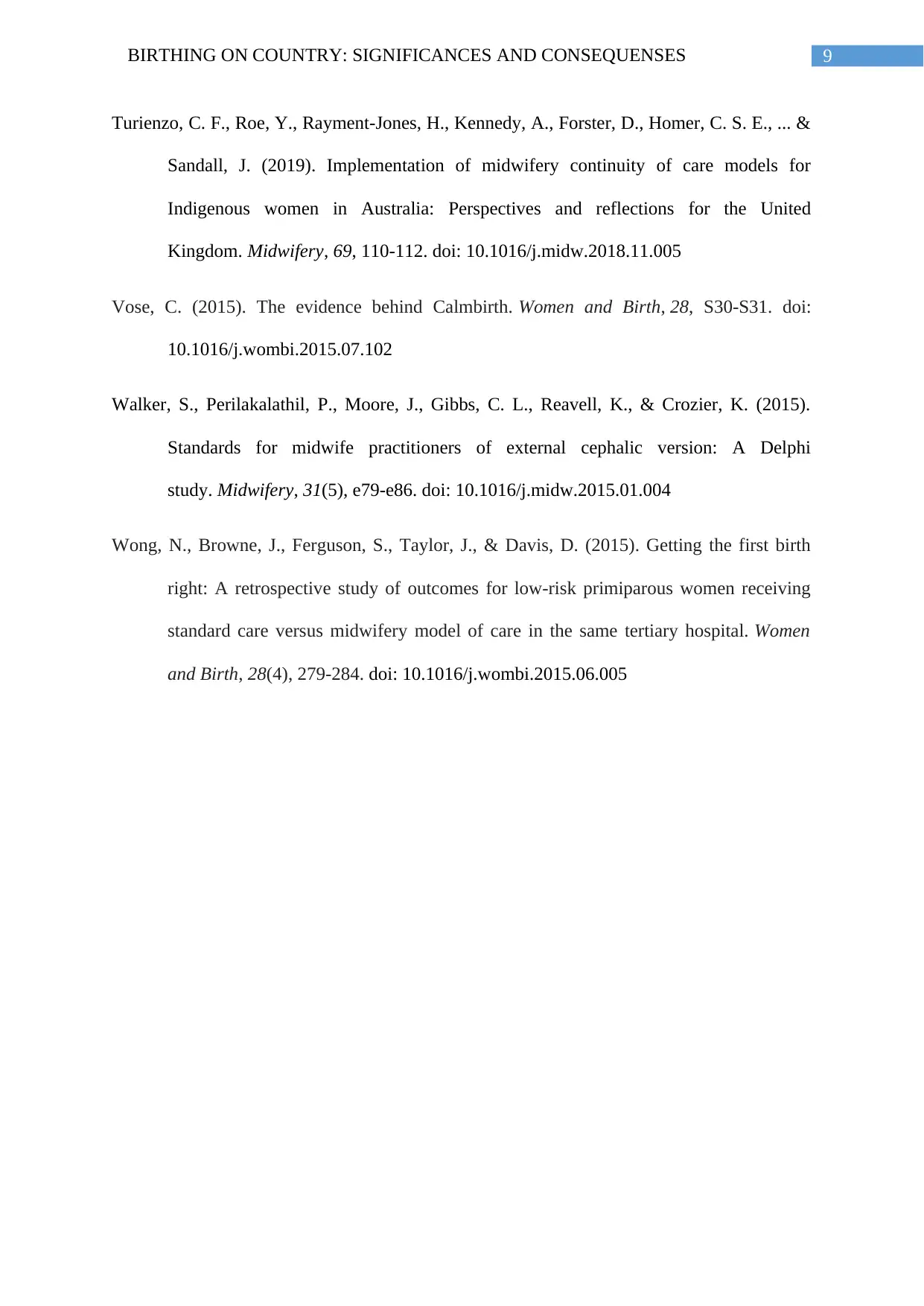
9BIRTHING ON COUNTRY: SIGNIFICANCES AND CONSEQUENSES
Turienzo, C. F., Roe, Y., Rayment-Jones, H., Kennedy, A., Forster, D., Homer, C. S. E., ... &
Sandall, J. (2019). Implementation of midwifery continuity of care models for
Indigenous women in Australia: Perspectives and reflections for the United
Kingdom. Midwifery, 69, 110-112. doi: 10.1016/j.midw.2018.11.005
Vose, C. (2015). The evidence behind Calmbirth. Women and Birth, 28, S30-S31. doi:
10.1016/j.wombi.2015.07.102
Walker, S., Perilakalathil, P., Moore, J., Gibbs, C. L., Reavell, K., & Crozier, K. (2015).
Standards for midwife practitioners of external cephalic version: A Delphi
study. Midwifery, 31(5), e79-e86. doi: 10.1016/j.midw.2015.01.004
Wong, N., Browne, J., Ferguson, S., Taylor, J., & Davis, D. (2015). Getting the first birth
right: A retrospective study of outcomes for low-risk primiparous women receiving
standard care versus midwifery model of care in the same tertiary hospital. Women
and Birth, 28(4), 279-284. doi: 10.1016/j.wombi.2015.06.005
Turienzo, C. F., Roe, Y., Rayment-Jones, H., Kennedy, A., Forster, D., Homer, C. S. E., ... &
Sandall, J. (2019). Implementation of midwifery continuity of care models for
Indigenous women in Australia: Perspectives and reflections for the United
Kingdom. Midwifery, 69, 110-112. doi: 10.1016/j.midw.2018.11.005
Vose, C. (2015). The evidence behind Calmbirth. Women and Birth, 28, S30-S31. doi:
10.1016/j.wombi.2015.07.102
Walker, S., Perilakalathil, P., Moore, J., Gibbs, C. L., Reavell, K., & Crozier, K. (2015).
Standards for midwife practitioners of external cephalic version: A Delphi
study. Midwifery, 31(5), e79-e86. doi: 10.1016/j.midw.2015.01.004
Wong, N., Browne, J., Ferguson, S., Taylor, J., & Davis, D. (2015). Getting the first birth
right: A retrospective study of outcomes for low-risk primiparous women receiving
standard care versus midwifery model of care in the same tertiary hospital. Women
and Birth, 28(4), 279-284. doi: 10.1016/j.wombi.2015.06.005
1 out of 10
Related Documents
Your All-in-One AI-Powered Toolkit for Academic Success.
+13062052269
info@desklib.com
Available 24*7 on WhatsApp / Email
![[object Object]](/_next/static/media/star-bottom.7253800d.svg)
Unlock your academic potential
© 2024 | Zucol Services PVT LTD | All rights reserved.




